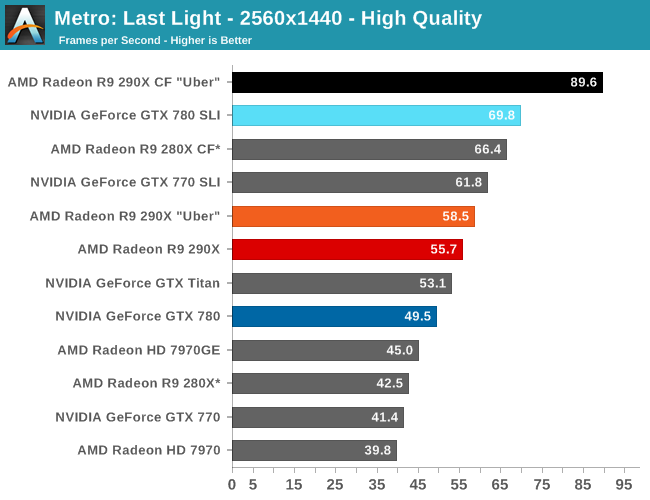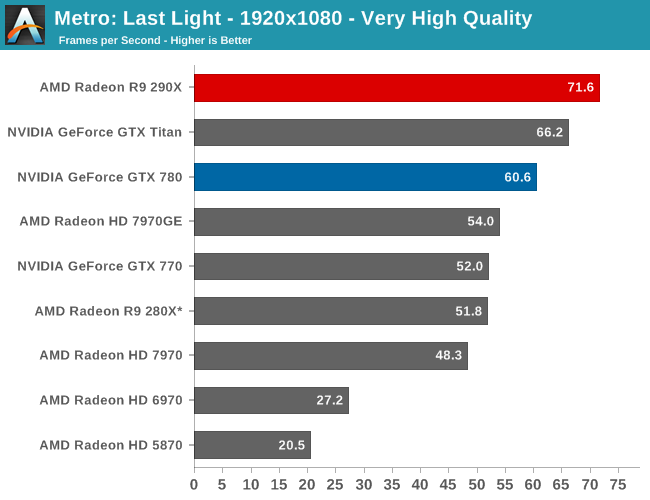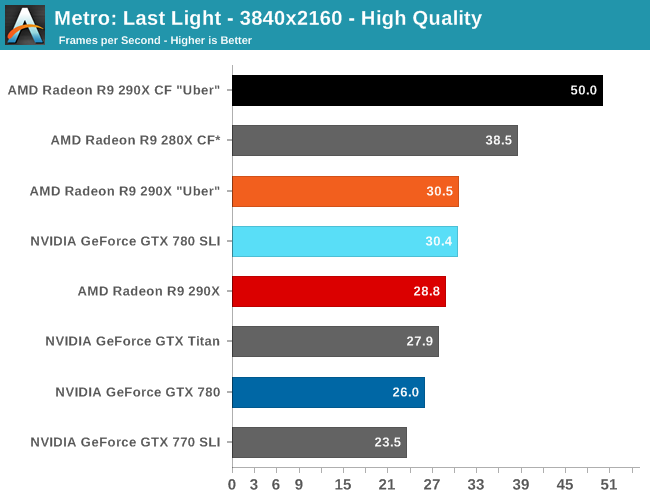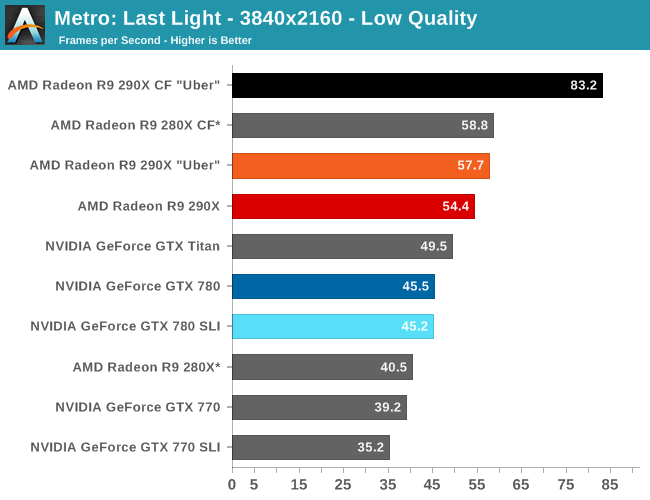The AMD Radeon R9 290X Review
by Ryan Smith on October 24, 2013 12:01 AM EST- Posted in
- GPUs
- AMD
- Radeon
- Hawaii
- Radeon 200
Metro: Last Light
As always, kicking off our look at performance is 4A Games’ latest entry in their Metro series of subterranean shooters, Metro: Last Light. The original Metro: 2033 was a graphically punishing game for its time and Metro: Last Light is in its own right too. On the other hand it scales well with resolution and quality settings, so it’s still playable on lower end hardware.


For the bulk of our analysis we’re going to be focusing on our 2560x1440 results, as monitors at this resolution will be what we expect the 290X to be primarily used with. A single 290X may have the horsepower to drive 4K in at least some situations, but given the current costs of 4K monitors that’s going to be a much different usage scenario.
With that said, for focusing on 4K on most games we’ve thrown in results both at a high quality setting, and a lower quality setting that makes it practical to run at 4K off of a single card. Given current monitor prices it won’t make a ton of sense to try to go with reduced quality settings just to save $550 – and consequently we may not keep the lower quality benchmarks around for future articles – but for the purposes of looking at a new GPU it’s useful to be able to look at single-GPU performance at framerates that are actually playable.
With that said, starting off with Metro at 2560 the 290X hits the ground running on our first benchmark. At 55fps it’s just a bit shy of hitting that 60fps average we love to cling to, but among all of our single-GPU cards it is the fastest, beating even the traditional powerhouse that is GTX Titan. Consequently the performance difference between 290X and GTX 780 (290X’s real competition) is even greater, with the 290X outpacing the GTX 780 by 13%, all the while being $100 cheaper. As we’ll see these results are a bit better than the overall average, but all told we’re not too far off. For as fast as GTX 780 is, 290X is going to be appreciably (if not significantly) faster.
290X also does well for itself compared to the Tahiti based 280X. At 2560 the 290X’s performance advantage stands at 31%, which as we alluded to earlier is greater than the increase in die size, offering solid proof that AMD has improved their performance per mm2 of silicon despite the fact that they’re still on the same 28nm manufacturing process. That 31% does come at a price increase of 83% however, which although normal for this price segment serves as a reminder that the performance increases offered by the fastest video cards with the biggest GPUs do not come cheaply.
Meanwhile for one final AMD comparison, let’s quickly look at the 290X in uber mode. As the 290X is unable to sustain the power/heat workload of a 1000MHz Hawaii GPU for an extended period of time, at its stock (quiet settings) it has to pull back on performance in order to meet reasonable operational parameters. Uber mode on the other hand represents what 290X and the Hawaii can do when fully unleashed; the noise costs won’t be pretty (as we’ll see), but in the process it builds on 290X’s existing leads and increases them by another 5%. And that’s really going to be one of the central narratives for 290X once semi-custom and fully-custom cards come online: Despite being a fully enabled part, 290X does not give us everything Hawaii is truly capable of.


Moving on, let’s talk about multi-GPU setups and 4K. Metro is a solid reminder that not every game scales similarly across different GPUs, and for that matter that not every game is going to significantly benefit from multi-GPU setups. Metro for its part isn’t particularly hospitable to multi-GPU cards, with the best setup scaling by only 53% at 2560. This is better than some games that won’t scale at all, but it won’t be as good as those games that see a near-100% performance improvement. Which consequently is also why we dropped Metro as a power benchmark, as this level of scaling is a poor showcase for the power/temp/noise characteristics of a pair of video cards under full load.
The real story here of course is that it’s another strong showing for AMD at both 2560 and 4K. At 2560 the 290X CF sees better performance scaling than the GTX 780 SLI – 53% versus 41% – further extending the 290X’s lead. Bumping the resolution up to 4K makes things even more lopsided in AMD’s favor, as at this point the NVIDIA cards essentially fail to scale (picking up just 17%) while the 290X sees an even greater scaling factor of 63%. As such for those few who can afford to seriously chase 4K gaming, the 290X is the only viable option in this scenario. And at 50fps average for 4K at high quality, 4K gaming at reasonable (though not maximum) quality settings is in fact attainable when it comes to Metro.
Meanwhile for single-GPU configurations at 4K, 4K is viable, but only at Metro’s lowest quality levels. This will be the first of many games where such a thing is possible, and the first of many games where going up to 4K in this manner further improves on AMD’s lead at 4K. Again, we’re not of the opinion that 4K at these low quality settings is a good way to play games, but it does provide some insight and validationg into AMD’s claims that their hardware is better suited for 4K gaming.










396 Comments
View All Comments
SolMiester - Monday, October 28, 2013 - link
So you can OC a 780 on stock, but not the 290x to sustain the OC, which means 780 wins!, especially after the price drop to $500!, oh dear AMD 290x just went from hero to zero...TheJian - Friday, October 25, 2013 - link
I gave links and named the games previously...See my post. At 1080p 780 trades blows depending on the games. Considering 98.75% of us are 1920x1200 or less, that is important and you get 3 AAA games with 780, on top of the fact that it's using far less watts, less noise and less heat. A simple drop in price of $50-100 and 780 seems like a no brainer to me (disregarding the 780TI which should keep the same price as now I'd guess). Granted Titan needs a dunk in price now too, which I'm sure will come or they'll just replace it with a full SMX up-clocked titan to keep that price. I'm guessing old titan just died as 780TI will likely beat it in nearly everything if the rumored clock speed and extra smx are true. They will have to release a new titan ULTRA or something with another smx or up the mhz to 1ghz or something. OR hopefully BOTH.I'm guessing it's easier to just up the 100mhz or put it to 1ghz as surely manufacturing has gotten them to where all will do this now, more than having all SMX's defect free. Then again if you have a bad SMX just turn a few more off and it's a 780TI anyway. They've had 8 months to either pile up cherry picked ones, or just improve totally anyway so more can do this easily. Clearly 780ti was just waiting in the wings already. They were just waiting to see 290x perf and estimates.
eddieveenstra - Sunday, October 27, 2013 - link
Titan died when 780gtx entered the room at 600 Euro. I'm betting Nvidia only brings a 780gtx ti and that's it. Titan goes EOL.anubis44 - Thursday, October 24, 2013 - link
This is the reference card. It's not loud unless you set it to 'Uber' mode, and even then, HardOCP thought the max fan speed should be set to 100% rather than 55%. Imagine how quiet an Asus Direct CUIII or Gigabyte Windforce or Sapphire Toxic custom cooled R9 290x will be.Crossfire and frame pacing all working, and R9 290X crushes Titan in 4K gaming (read HardOCP's review of this 4K section), all while costing $100 less than GTX780, and the R9 280X (7970) is priced at $299, and the R9 270X (7870) is now going for $180, and now Mantle API could be the next 3dfx Glide, and boost all 7000-series cards and higher dramatically for free...
It's like AMD just pulled out a light sabre and cut nVidia right in half while Jsen Hsun just stares dumbly at them in disbelief. He should have merged nVidia with AMD when he had the chance. Could be too late now.
Shark321 - Thursday, October 24, 2013 - link
There will be no custom cooling solution for the time being. It's the loudest card ever released. Twice as loud as 780/Titan in BF3 after 10 minutes of playing. Also Nvidia will bringt the 780Ti in 3 weeks, a faster cart at a comparable price, but quiet. AMD releases the 290x one year after NVidia, 2 years after NVidias tipeout. Nvidia will be able to counter this with a wink.just4U - Thursday, October 24, 2013 - link
Shark Writes: "It's the loudest card ever released."Guess you weren't around for the Geforce5...
HisDivineOrder - Thursday, October 24, 2013 - link
The FX5800 is not ever dead. Not if we remember the shrill sound of its fans......or if the sound burned itself into our brains for all time.
Samus - Friday, October 25, 2013 - link
I think the 65nm GeForce 280 takes the cake for loudest card ever made. It was the first card with a blower.ninjaquick - Thursday, October 24, 2013 - link
lol, the Ti can only do so much, there is no smaller node for either company to jump to, not until March for enough shipments to have stock for sales. The 290X just proves AMD's GCN design is a keeper. It is getting massively throttled by heat and still manages to pull a slight lead over the titan, at sometimes 15% lower clocks than reference. AMD needed a brand for this release season, and they have it.Both Nvidia and AMD are jumping to the next node in 2014. Nvidia will not release Maxwell on the current node. And there is no other node they would invest in going to.
HisDivineOrder - Thursday, October 24, 2013 - link
The Ti could theoretically open up all the disabled parts of the current GK110 part. Doing that, who knows what might happen? We've yet to see a fully enabled GK110. I suspect that might eat away some of the Titan's efficiency advantage, though.